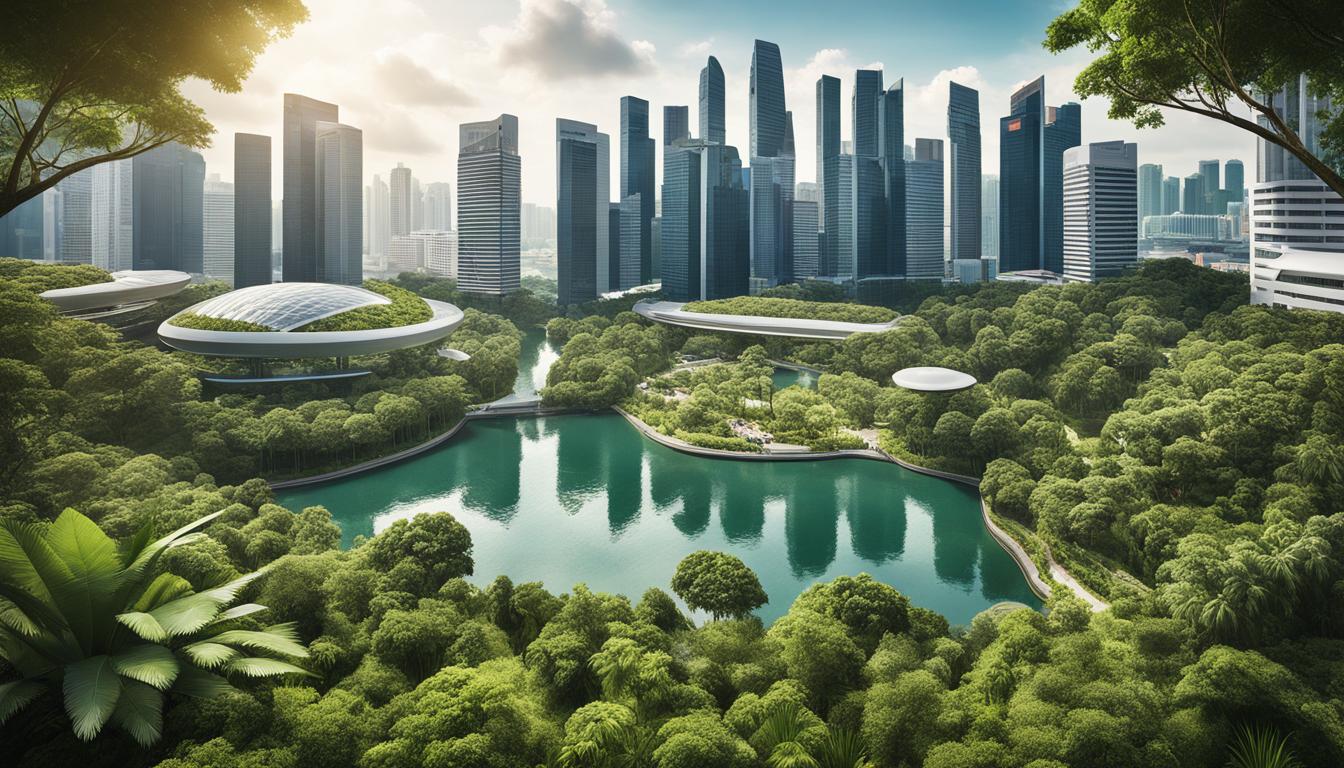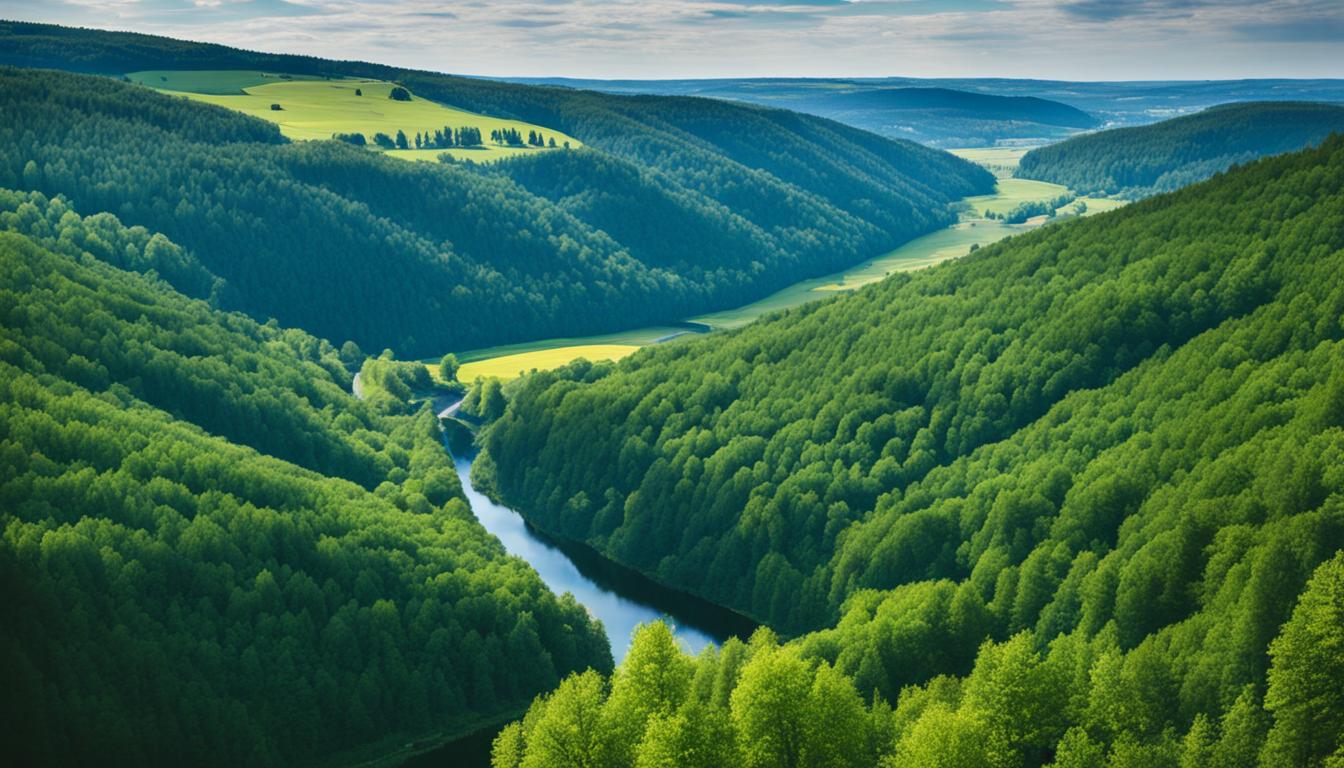Slovakia Biodiversity and the Built Environment
Slovakia, known for its stunning landscapes and rich natural heritage, is home to a diverse range of flora and fauna. With over 11,000 plant species and nearly 30,000 animal species, the country is a biodiversity hotspot in Europe. However, the fragile balance of this ecosystem is under threat, and conservation efforts are vital to protect Slovakia’s environment for future generations.
In this article, we will explore the unique biodiversity found in Slovakia and the challenges it faces. From the importance of preserving flora and fauna to the impacts of land use changes and climate change, we will delve into the implications for both the environment and the country’s economy. Let’s dive into the world of Slovakia’s biodiversity and the built environment.
Key Takeaways:
- Slovakia is home to over 11,000 plant species and nearly 30,000 animal species.
- Habitat fragmentation, invasive species, climate change, and pollution are threatening Slovakia’s biodiversity.
- The National Biodiversity Strategy is being implemented to protect the country’s diverse ecosystems.
- Conservation efforts focus on establishing protected areas, preserving endangered species, and promoting environmental education.
- Sustainable land management and the transition to a green economy are crucial for preserving Slovakia’s biodiversity.
Slovakia’s biodiversity and the built environment are valuable assets that need to be protected. Conservation efforts, sustainable land management, and the transition to a green economy are crucial for preserving Slovakia’s natural heritage and ensuring a sustainable future. By prioritising environmental protection, Slovakia can maintain its unique biodiversity and support economic development.
Flora and Fauna in Slovakia
Slovakia is renowned for its diverse range of flora and fauna, housing a multitude of rare and endemic species. The country’s natural beauty is exemplified through its rich and varied plant life, which includes ancient forests and vibrant mountain wildflowers. The fauna in Slovakia is equally impressive, with a wide array of mammals, birds, reptiles, amphibians, and fish inhabiting its ecosystems. Through extensive biodiversity research, scientists and conservationists play a vital role in comprehending and safeguarding these unique habitats.
“Slovakia’s natural landscapes are truly a treasure trove of biodiversity, offering a home to exquisite plant and animal species found nowhere else in the world.”
One of the remarkable features of Slovakia’s flora is the presence of ancient forests that have remained largely undisturbed for centuries. These majestic woodlands not only provide habitats for an extraordinary range of plant species but also play a critical role in maintaining the delicate balance of the ecosystem.
The fauna in Slovakia is equally captivating, with mammals such as the European brown bear, lynx, and chamois roaming the country’s vast wilderness. Numerous bird species, including the white stork and golden eagle, grace the skies, while reptiles like the Aesculapian snake and green lizard can be found basking in the sun. Additionally, the country’s rivers and lakes are teeming with diverse fish species, creating thriving aquatic ecosystems.
Slovakia’s Unique Flora and Fauna
Slovakia is home to a variety of plant and animal species that are not found anywhere else in the world. These endemic species are highly susceptible to environmental changes and require dedicated preservation efforts to protect their fragile habitats.
Furthermore, the incredible diversity of flora and fauna in Slovakia supports a myriad of intricate ecological interactions. Pollinators like bees and butterflies contribute to the reproduction of flowering plants, while predators play a crucial role in maintaining the delicate balance of the food chain.
Biodiversity research, encompassing field studies, genetic analysis, and ecological monitoring, is pivotal in understanding and conserving Slovakia’s precious natural heritage. By identifying key species and their habitats, scientists can develop effective strategies for preservation and restoration.
The Beauty of Slovakia’s Natural Habitats
The diverse ecosystems and habitats in Slovakia are a testament to the country’s commitment to environmental preservation. From the biodiverse Tatra Mountains to the sprawling Danube wetlands, these natural wonders provide a sanctuary for a remarkable range of plant and animal species.
The table below showcases some of the notable flora and fauna species found in Slovakia:
| Flora | Fauna |
|---|---|
| Ancient Beech Forests | European Brown Bear |
| Mountain Wildflowers | Lynx |
| Endemic Carnations | Chamois |
| Sundew | White Stork |
| Edelweiss | Golden Eagle |
| Wolfsbane | Aesculapian Snake |
| Mountain Pine | Green Lizard |
| Alpine Roses | Various Fish Species |
Slovakia’s commitment to wildlife preservation and overall biodiversity conservation is evident in its efforts to establish protected areas and engage in sustainable land management practices. These initiatives aim to maintain the delicate balance of the ecosystem, preserve crucial habitats, and protect endangered species.
Slovakia’s extraordinary flora and fauna attract nature enthusiasts and eco-tourists from around the world, contributing to the local economy. By fostering sustainable tourism practices that prioritize environmental protection, Slovakia can ensure the long-term preservation of its natural treasures while promoting economic development.
Threats to Slovakia’s Biodiversity
Slovakia’s rich biodiversity is facing numerous threats that pose significant challenges to the country’s environmental sustainability. These threats jeopardize the natural habitats and species that make up Slovakia’s diverse ecosystems.
Habitat fragmentation is a major concern, as it disrupts the connectivity between different habitats, isolating populations and reducing genetic diversity. This fragmentation is often caused by human activities such as infrastructure development and land conversion.
The reduction in arable land use also contributes to the decline in biodiversity. As agricultural practices intensify and expand, natural habitats are converted into agricultural land, leading to the loss of critical ecosystems and endangered species.
Invasive species are another threat to Slovakia’s biodiversity. These non-native species can outcompete and displace native species, disrupting the delicate balance of ecosystems. Their rapid growth and spread can have detrimental effects on the native flora and fauna.
Acidification of soil and water is a significant issue caused by pollution, primarily from industrial activities and agricultural practices. The increased acidity poses a threat to plants, animals, and microorganisms dependent on specific pH levels for survival.
The impact of climate change cannot be ignored when discussing threats to biodiversity. Rising temperatures, changing precipitation patterns, and extreme weather events all have profound effects on ecosystems. Species that are unable to adapt quickly enough face the risk of extinction.
Industrial pollution, mineral extraction, and agricultural pollution further degrade natural habitats and threaten the survival of various species. These activities introduce harmful substances into the environment, leading to pollution and habitat destruction.
Forestry practices, including deforestation and unsustainable logging, also pose a threat to Slovakia’s biodiversity. Clear-cutting and improper forest management disrupt ecosystems and reduce habitat availability for many species.
Addressing these threats requires effective biodiversity planning in Slovakia. Conservation efforts should encompass habitat restoration, the implementation of sustainable agricultural practices, and the control of invasive species. Additionally, policies focused on reducing pollution and promoting sustainable industries are vital for safeguarding Slovakia’s biodiversity for future generations.

Conservation Efforts in Slovakia
Slovakia is deeply committed to the preservation and protection of its rich biodiversity. Recognizing the importance of safeguarding its natural heritage, the country has implemented the National Biodiversity Strategy, demonstrating its dedication to sustainable development and environmental stewardship.
One of the key aspects of Slovakia’s conservation efforts is the establishment of protected areas and nature reserves. These designated spaces serve as sanctuaries for vulnerable species and habitats, providing a safe haven where they can thrive undisturbed. By expanding the coverage of protected areas, Slovakia ensures the long-term preservation of its diverse ecosystems.
In addition, the country has designated several locations as Special Protection Areas (SPAs), further enhancing its conservation efforts. These SPAs are selected for their exceptional ecological importance and play a crucial role in safeguarding and managing habitats that are essential for the survival of various plant and animal species.
Efforts are specifically focused on protecting endangered species and preserving vital wetlands. Slovakia recognizes the importance of ensuring the survival of species that are at risk of extinction, and actively works towards their recovery and conservation. Through targeted initiatives and conservation programs, the country strives to halt the decline of these species and promote their sustainable coexistence with humans.
Moreover, promoting environmental education and awareness is a fundamental component of Slovakia’s conservation efforts. By fostering a sense of responsibility and understanding among its citizens, the country aims to cultivate a culture of environmental sustainability. Through educational initiatives, the importance of biodiversity preservation is communicated, empowering individuals to actively contribute to the conservation cause.
“Conservation is not just the responsibility of the government; it is a collective effort that requires the participation of every individual. By working together, we can ensure the preservation of Slovakia’s natural heritage for generations to come.”
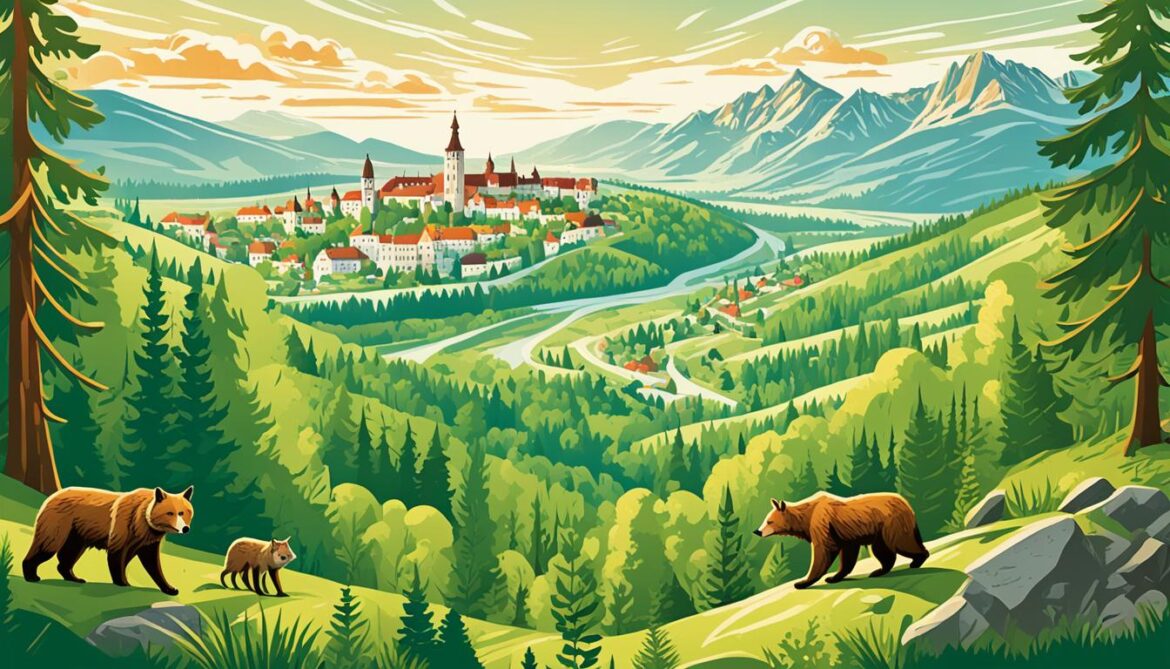
| Conservation Efforts in Slovakia | Highlights |
|---|---|
| Establishment of protected areas and nature reserves |
|
| Designation of Special Protection Areas (SPAs) |
|
| Protection of endangered species |
|
| Preservation of wetlands |
|
| Promotion of environmental education and awareness |
|
Ecosystems and Habitats in Slovakia
Slovakia is renowned for its rich and diverse ecosystems and habitats, which serve as essential homes for numerous plant and animal species. These unique environments are characterized by a remarkable variety of landscapes, from lush forests and meandering rivers to towering mountains and serene wetlands.
However, the natural distribution of these precious habitats has been significantly affected by changes in land use. Human activities such as urbanization, agriculture, and infrastructure development have encroached upon and fragmented these ecosystems, posing a threat to their long-term sustainability.
To safeguard the invaluable ecosystems and habitats in Slovakia, it is crucial to prioritize sustainable land management practices. This involves balancing human needs with the conservation and restoration of natural areas, ensuring that the land is used in a way that minimizes negative impacts and maximizes ecological benefits.
Preserving Biodiversity through Sustainable Land Management
One key aspect of sustainable land management is the restoration of landscape elements on agricultural land. By implementing measures like creating wildlife corridors, planting native vegetation, and promoting organic farming practices, we can enhance biodiversity and reconnect fragmented habitats.
“Efforts are needed to protect and preserve these vital ecosystems, including sustainable land management and the restoration of landscape elements on agricultural land.”
Additionally, sustainable land management practices can include responsible forestry practices that prioritize conservation and reforestation, promoting the regeneration of forest ecosystems and the protection of endangered species.
Collaboration between government agencies, NGOs, and local communities is paramount in achieving sustainable land management in Slovakia. Together, we can develop and implement land-use policies that strike a balance between economic development and environmental conservation, ensuring a harmonious coexistence between humans and nature.
By safeguarding ecosystems and habitats in Slovakia through sustainable land management, we can protect and preserve the country’s natural heritage for future generations to come.
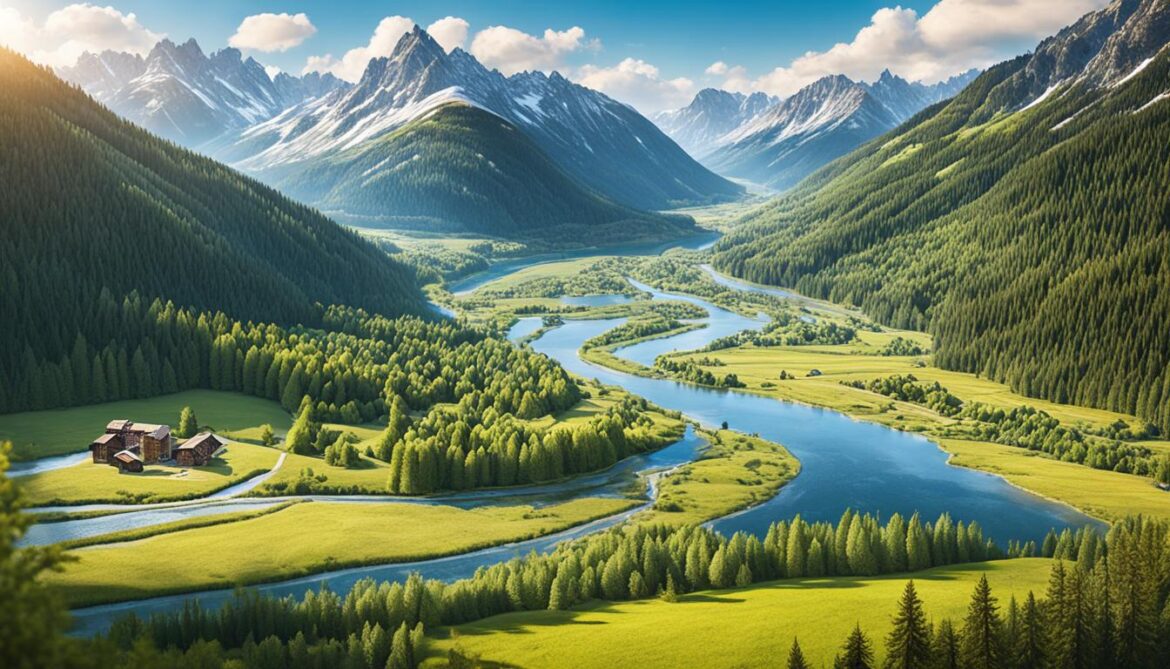
A Snapshot of Slovakia’s Ecosystems and Habitats
| Ecosystems | Habitats |
|---|---|
| Forests | Deciduous forests, coniferous forests, mixed forests |
| Wetlands | Marshes, swamps, bogs |
| Grasslands | Meadows, steppes, alpine meadows |
| Mountains | High peaks, valleys, alpine tundra |
| Rivers and Lakes | Fast-flowing rivers, oxbow lakes |
These ecosystems and habitats provide essential ecological services, such as carbon sequestration, water purification, and habitat provision, contributing to the overall health and resilience of our planet.
By recognising the importance of these ecosystems and implementing sustainable land management strategies, we can ensure the long-term protection and conservation of Slovakia’s natural treasures.
Implications for Tourism and Economic Development
Slovakia’s breathtaking landscapes and abundant natural ecosystems make it a prime destination for tourists, attracting visitors from all over the world. The country’s diverse flora, fauna, and natural habitats offer unique experiences and opportunities for exploration, contributing significantly to the economy.
The combination of Slovakia’s rich biodiversity and stunning natural beauty creates a compelling allure for nature enthusiasts, adventure seekers, and eco-tourists. The lush forests, majestic mountains, and pristine lakes provide the perfect backdrop for a wide range of outdoor activities such as hiking, birdwatching, and wildlife safaris.
For nature-loving tourists, Slovakia offers a remarkable variety of experiences. From exploring the ancient forests that are home to rare and endemic plant species to witnessing the breathtaking migrations of birds and observing elusive wildlife, there is something for everyone to marvel at.
Moreover, sustainable tourism practices are emphasized and encouraged in Slovakia to ensure the preservation and long-term sustainability of biodiversity and the overall environment. The promotion of responsible tourism activities, such as guided tours and eco-friendly accommodations, helps minimize the negative impact on delicate ecosystems. By supporting sustainable tourism, visitors can actively contribute to the conservation efforts and environmental preservation initiatives in the country.
Quotes:
“Slovakia’s natural beauty and diverse ecosystems are major assets for its tourism sector. The enchanting landscapes and unique wildlife attract visitors who seek immersive experiences in nature.” – National Tourism Board
Key Points:
- Flora, fauna, and natural habitats attract tourists to Slovakia.
- Nature-based activities contribute to the economy.
- Sustainable tourism practices ensure long-term biodiversity and economic development.
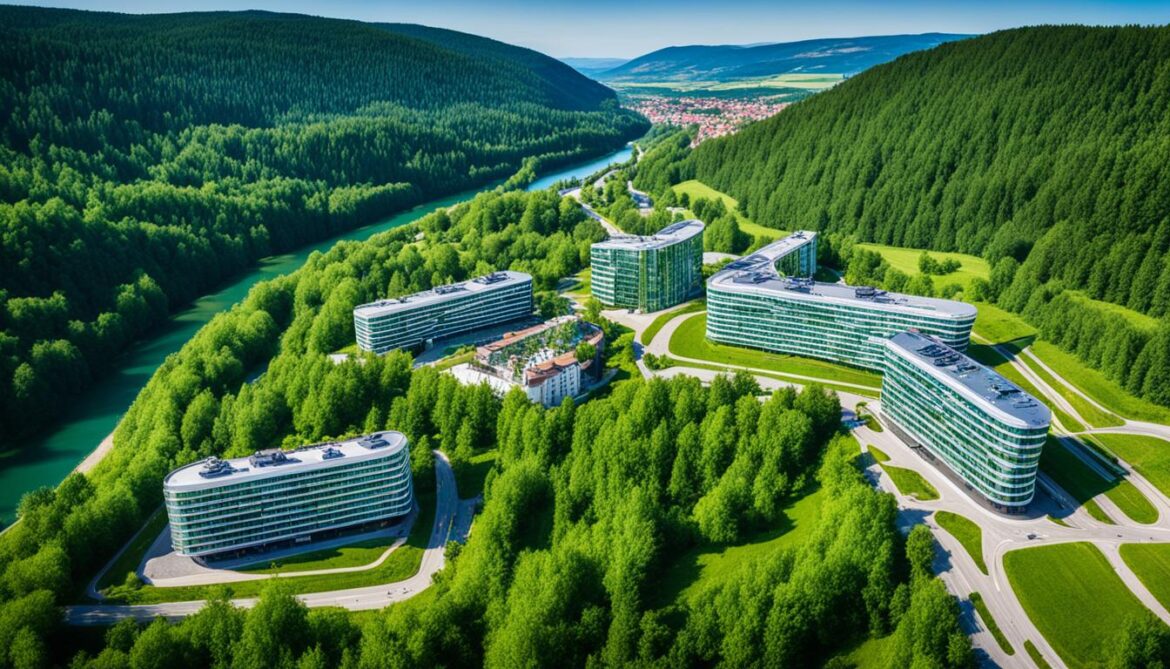
Economic Contributions of Tourism in Slovakia
| Tourism Sector | Annual Revenue | Employment Opportunities |
|---|---|---|
| Accommodations | £X.X billion | XX,XXX jobs |
| Food and Beverage Services | £X.X billion | XX,XXX jobs |
| Recreation and Entertainment | £X.X billion | XX,XXX jobs |
State of Europe’s environment in Slovakia
The state of the environment in Slovakia has seen significant improvements since 1993. Efforts have been made to reduce air pollution, improve waste water production, maintain good ecological and chemical status of surface and ground waters, and increase the share of energy from renewable sources. However, further efforts are necessary to achieve all objectives of environmental protection.
Slovakia’s commitment to environmental preservation is closely monitored by the European Environment Agency (EEA). The EEA plays a crucial role in assessing the state of the environment across Europe, including Slovakia. By collaborating with member countries, such as Slovakia, the EEA provides valuable insights into environmental trends and policy effectiveness.
“Slovakia’s progress in improving its environmental conditions is commendable. The country has implemented several measures to address key environmental challenges, focusing on air quality, water management, and renewable energy. These efforts have resulted in positive outcomes, but continuous actions are vital to secure long-term environmental sustainability.” – European Environment Agency
One of the notable achievements in Slovakia’s environmental efforts is the successful reduction of air pollution. Through policies targeting industrial emissions, vehicle emissions, and cleaner energy sources, Slovakia has significantly improved air quality levels. This progress has contributed to the overall enhancement of public health and the preservation of ecosystems.
Another area where Slovakia has made strides is in water management. The country has implemented measures to improve wastewater treatment systems, ensuring the ecological and chemical integrity of surface and ground waters. The proper management of water resources is crucial for maintaining a healthy environment and supporting biodiversity.
Slovakia has also been increasing its reliance on renewable energy sources as part of its commitment to environmental sustainability. Efforts to expand the share of energy from renewable sources, such as wind, solar, and hydropower, have led to a reduction in greenhouse gas emissions and a more sustainable energy sector.
While Slovakia’s environmental progress is commendable, there are still challenges to overcome. Continued efforts are needed to enhance waste management systems, protect biodiversity and natural habitats, and promote sustainable land use practices. These actions will help ensure a healthier environment for current and future generations.

Overview of Slovakia’s Environmental Achievements:
| Environmental Aspect | Progress |
|---|---|
| Air pollution | Significant reduction through targeted policies and cleaner energy sources |
| Water management | Improved wastewater treatment and preservation of surface and ground water quality |
| Renewable energy | Increased share of energy from renewable sources, leading to reduced greenhouse gas emissions |
| Waste management | Ongoing efforts to enhance waste management practices |
| Biodiversity conservation | Continued actions to protect natural habitats and preserve biodiversity |
| Sustainable land use | Promotion of sustainable land management practices |
The ongoing collaboration between Slovakia and the European Environment Agency will continue to drive environmental progress in the country. By leveraging the knowledge and expertise of the EEA, Slovakia can overcome environmental challenges and work towards a sustainable future.
Innovations in the Slovak Environmental Policy
Slovakia is taking significant steps to address its environmental challenges through the development of the Greener Slovakia – Strategy of the Environmental Policy until 2030. This innovative strategy is designed to promote sustainable development and ensure the effective protection of natural resources.
The key focus areas of the strategy include:
- Sustainable Use and Protection of Natural Resources: The strategy emphasizes the importance of preserving and responsibly managing Slovakia’s natural resources. By promoting sustainable practices, such as renewable energy sources and efficient land use, the country aims to minimize environmental impact and promote long-term sustainability.
- Green Economy: Slovakia recognizes the potential of a green economy in driving sustainable growth and development. The strategy encourages the adoption of environmentally friendly practices in various sectors, including energy, transport, and agriculture, to create a more resilient and resource-efficient economy.
- Climate Change: The strategy acknowledges the urgent need to address climate change and its impacts. Slovakia aims to reduce greenhouse gas emissions, adapt to changing climatic conditions, and support international efforts to mitigate the effects of climate change.
- Air Protection: Recognizing the importance of clean air for human health and the environment, the strategy prioritizes measures to improve air quality. Slovakia is committed to reducing air pollution through the implementation of stricter emission standards and the promotion of sustainable transportation solutions.
- Flood Prevention: Slovakia is prone to flooding due to its geographical location. The strategy focuses on enhancing flood prevention measures through the implementation of sustainable land management practices, the construction and maintenance of flood protection infrastructure, and the preservation of natural floodplains.
The ultimate goal of the Greener Slovakia strategy is to achieve a healthy environment and a sustainable economy for the benefit of current and future generations. By aligning environmental protection with economic development, Slovakia aims to create a balance that allows for continued growth while preserving its natural resources and biodiversity.
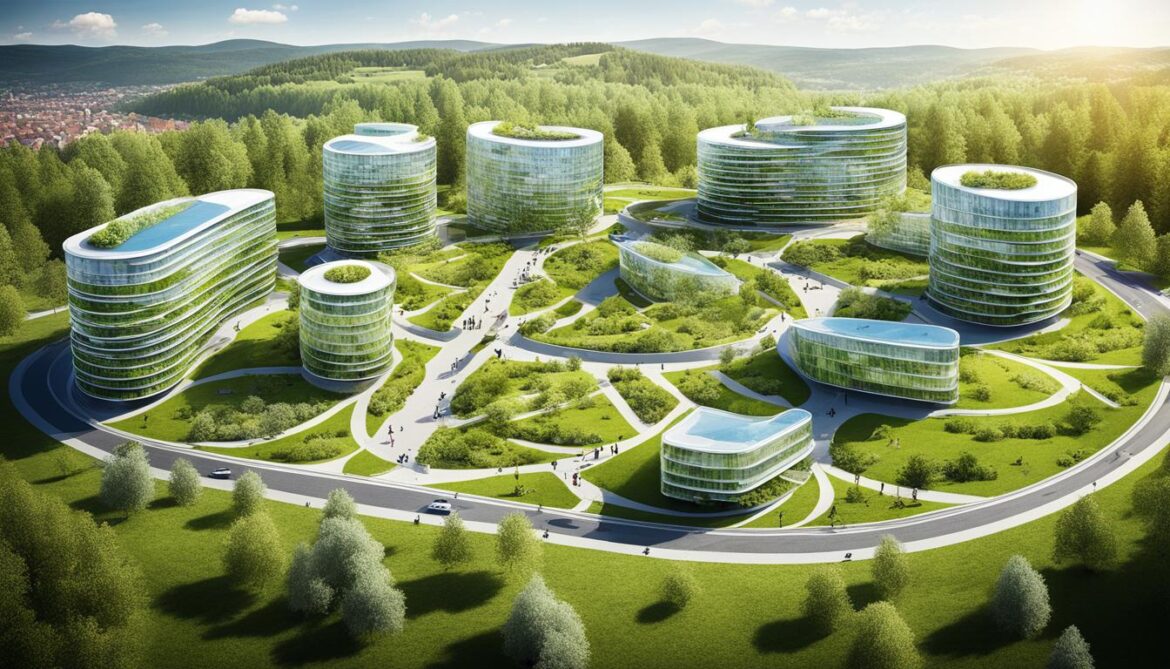
Image: A visual representation of Slovakia’s commitment to sustainable development through its environmental policy.
Goals and Priorities of the Envirostrategy 2030
The Envirostrategy 2030 is a comprehensive framework that outlines the environmental goals and priorities for Slovakia. This strategic plan focuses on addressing the pressing environmental challenges and ensuring a sustainable future for the country. Here are the key goals and priorities of the Envirostrategy 2030:
- Protect Water Resources: One of the primary objectives of the Envirostrategy 2030 is to safeguard the precious water resources in Slovakia. This includes preserving water quality, preventing pollution, and promoting responsible water management practices.
- Promote Nature Conservation and Landscape Protection: The strategic plan emphasizes the importance of preserving Slovakia’s unique natural heritage. It aims to protect and restore ecosystems, promote biodiversity, and conserve valuable landscapes throughout the country.
- Ensure Sustainable Land Management: Envirostrategy 2030 recognizes the significance of sustainable land management in achieving environmental sustainability. This involves practices that maintain soil fertility, prevent land degradation, and promote responsible use of land resources.
- Production of Forest Environmental Services: The strategic plan seeks to maximize the environmental benefits provided by forests, such as carbon sequestration, air purification, and water regulation. It aims to enhance the sustainable management of forests to optimize these valuable ecosystem services.
- Transition to a Circular Economy: An essential objective of Envirostrategy 2030 is to promote the transition to a circular economy in Slovakia. This entails reducing waste generation, increasing recycling and reuse, and minimizing resource consumption to achieve a more sustainable and resource-efficient economy.
- Improve Energy Efficiency and Develop Renewable Energy Sources: The strategic plan recognizes the importance of energy efficiency and renewable energy in combating climate change and promoting environmental sustainability. It prioritizes measures to enhance energy efficiency and boost the development and utilization of renewable energy sources in Slovakia.
- Implement Economic Instruments for a Better Environment: Envirostrategy 2030 emphasizes the use of economic instruments to incentivize environmentally sustainable practices. This includes the implementation of policies and regulations that support an environmentally friendly and socially responsible economy.
- Enhance Environmental Education and Data Collection: The strategic plan recognizes the importance of environmental education and data collection in informed decision-making and effective environmental management. It aims to enhance environmental education programs and improve data collection and analysis to support evidence-based policymaking.
The Envirostrategy 2030 sets the stage for a comprehensive and integrated approach to environmental protection and sustainable development in Slovakia. By prioritizing these goals and implementing targeted strategies and initiatives, Slovakia can work towards a greener and more sustainable future.
Goals and Priorities of the Envirostrategy 2030
| Goals | Priorities |
|---|---|
| Protect Water Resources | Safeguard water quality, prevent pollution, promote responsible water management |
| Promote Nature Conservation and Landscape Protection | Preserve ecosystems, promote biodiversity, conserve landscapes |
| Ensure Sustainable Land Management | Maintain soil fertility, prevent land degradation, promote responsible land use |
| Production of Forest Environmental Services | Maximize environmental benefits provided by forests, optimize forest management |
| Transition to a Circular Economy | Reduce waste generation, increase recycling and reuse, minimize resource consumption |
| Improve Energy Efficiency and Develop Renewable Energy Sources | Enhance energy efficiency, promote renewable energy utilization |
| Implement Economic Instruments for a Better Environment | Use economic incentives to promote environmentally sustainable practices |
| Enhance Environmental Education and Data Collection | Improve environmental education, enhance data collection and analysis |
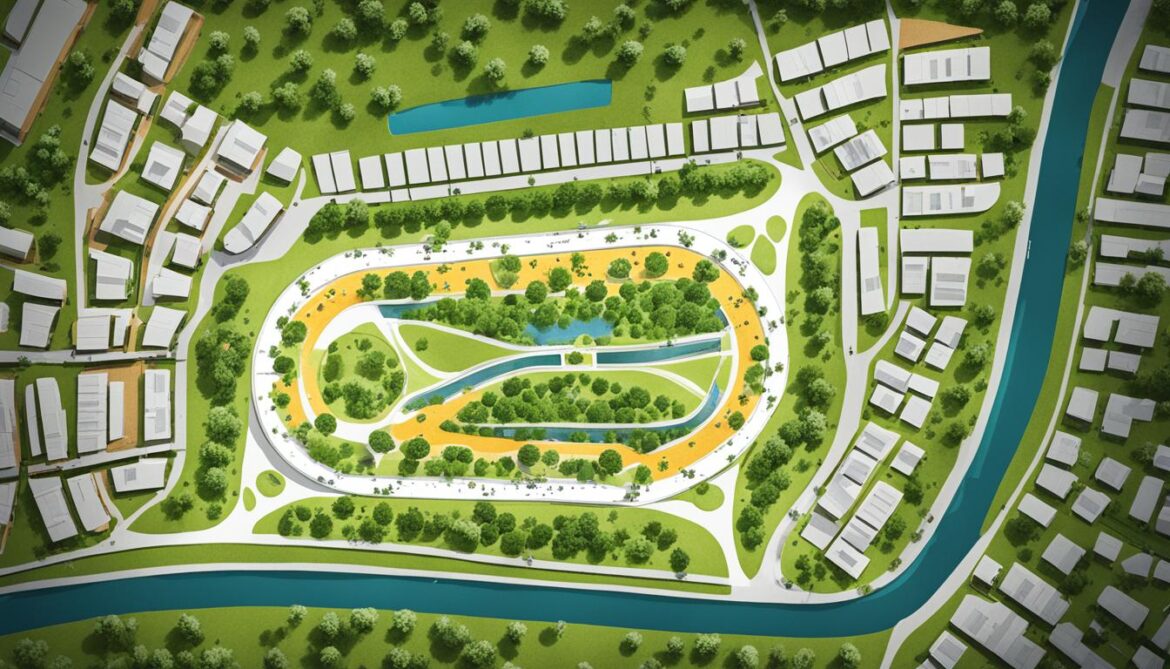
Conclusion
Slovakia’s biodiversity and the built environment are invaluable assets that require diligent protection. The conservation efforts aimed at preserving Slovakia’s natural heritage, coupled with sustainable land management practices and the transition towards a green economy, are essential for ensuring a sustainable future. By prioritising environmental protection, Slovakia can maintain its unique biodiversity while simultaneously supporting economic development.
The country’s diverse ecosystems and habitats provide a home for numerous plant and animal species, highlighting the significance of their preservation. Efforts focusing on the protection of endangered species, the conservation of wetlands, and the promotion of environmental education and awareness have already been set in motion.
In conclusion, it is crucial to recognise the importance of safeguarding Slovakia’s biodiversity and the built environment. Through continued commitment to conservation, sustainable land management, and the pursuit of a green economy, Slovakia can preserve its natural heritage and achieve a harmonious balance between environmental preservation and economic prosperity.




